The Proceedings of the 82nd session of Indian History Congress held at the Kakatiya University (4)
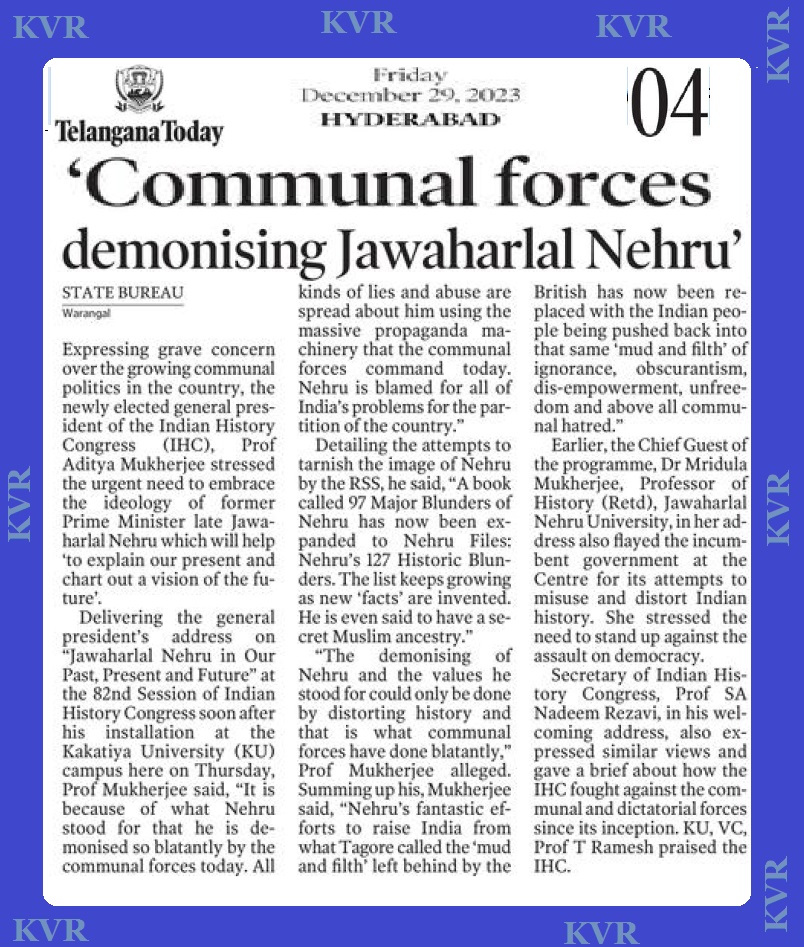
IHC opposing RSS for demonizing Nehru: Expressing grave concern over the growing communal politics in the country, the newly elected General President of the Indian History Congress (IHC), Prof Aditya Mukherjee stressed the need to embrace the ideology of former Prime Minister late Jawaharlal Nehru which will help ‘to explain our present and chart out a vision of the future[1]’. Delivering the General President’s address on “Jawaharlal Nehru in Our Past, Present and Future” at the 82nd Session of Indian History Congress soon after his installation at the Kakatiya University (KU) campus here on 28-12-2023, Thursday, Prof Mukherjee said, “It is because of what Nehru stood for that he is demonized so blatantly by the communal forces today[2]. All kinds of lies and abuse are spread about him using the massive propaganda machinery that the communal forces command today[3]. Nehru is blamed for all of India’s problems for the partition of the country.”[4] Detailing the attempts to tarnish the image of Nehru by the RSS, he said, “A book called 97 Major Blunders of Nehru has now been expanded to “Nehru Files: Nehru’s 127 Historic Blunders”. The list keeps growing as new ‘facts’ are invented. He is even said to have a secret Muslim ancestry.”

Why Aditya is repeating the stuff again and again?: “The demonizing of Nehru and the values he stood for could only be done by distorting history and that is what communal forces have done blatantly,” Prof Mukherjee alleged. Summing up his speech, Mukherjee said “Nehru’s fantastic efforts to raise India from what Tagore called the ‘mud and filth’ left behind by the British has now been replaced with the Indian people being pushed back into that same ‘mud and filth’ of ignorance, obscurantism, dis-empowerment, unfreedom and above all communal hatred.” Incidentally, it is noted that he has repeated the stuff that already appeared in the “National Herald,” the Congress mouth piece[5]. Ironically, the title also appears similar, “Why they demonize Nehru.”[6] Of course, in 2015 when he addressed a seminar at AMU organised ahead of November 14, the 126th birth anniversary of India’s first PM said[7], “it had become quite the fad to “demonize” India’s first prime minister and hold him responsible for whatever ails modern India. “This tendency can be countered with a proper reading of history”[8].
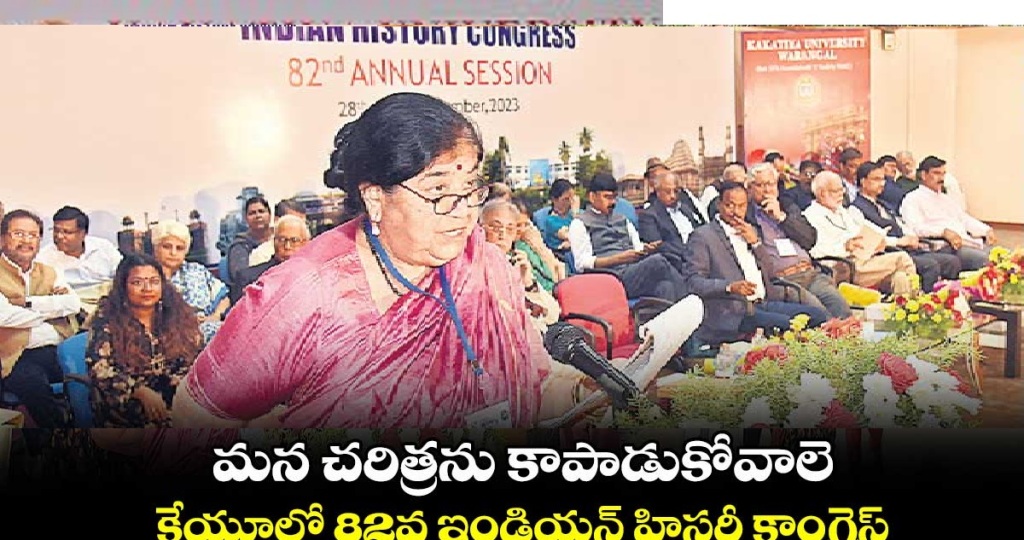
Mridula Mahajan flayed the incumbent government at the Centre: Earlier, the Chief Guest of the programme, Dr Mridula Mukherjee, Professor of History (Retd.), Jawaharlal Nehru University, in her address also flayed the incumbent government at the Centre for its attempts to misuse and distort Indian history. She stressed the need to stand up against the assault on democracy. It is not known why historians should be associated with any political party, when the talk about secularism, communalism, sectarianism, fascism and so on. Ironically, they have already been accused of holding Government jobs and as well as associating with political parties. In fact, Mridula faced such charges. When they preach to others for some values, then, they should first follow the same. We know what Sri Ramakrishna Paramahamsa has advised, “One should have the badge of authority for preaching, as otherwise, preaching becomes mockery”!

Mridula Mukherjee wrote “History of Congress Party”: Historian Mridula Mukherjee is a member of the editorial board that brought out the official history of the Congress, although she is the director of Nehru Memorial Museum & Library (NMML), an autonomous body under the ministry of culture[9]. As per the rules, she is prohibited from associating with any political party[10]. “Congress and the Making of Indian Nation”, a two-volume publication brought out by the Congress and released recently during its plenary session, has finance minister Pranab Mukherjee as chief editor and commerce minister Anand Sharma as convener of the editorial board[11]. The book was released by PM, who is also the culture minister, and Congress president Sonia Gandhi[12]. There is a team of professional historians associated with the project. Mridula, her husband Aditya Mukherjee, a professor of history at Jawaharlal Nehru University, her sister Sucheta Mahajan, also in JNU’s history department and Bhashyam Kasturi, her colleague in NMML, and Rizwan Qaiser, from the department of history and culture, Jamia Millia Islamia, are all part of the team. Kasturi is a contract employee. While sources in the JNU and Jamia administration could not confirm if association with a political party is flouting service rules, in case of Mridula Mukherjee, the violation is clear. She has just over eight months left of her tenure.
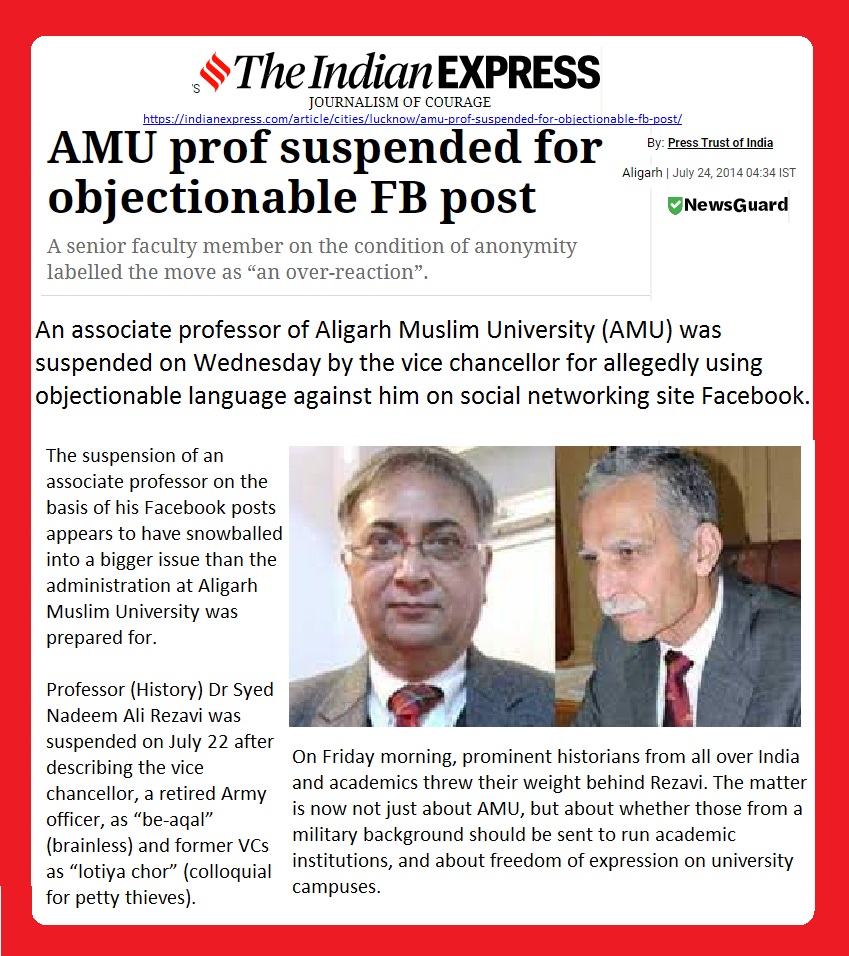
What S A Nadeem Rezavi talked about: Secretary of Indian History Congress, Prof S A Nadeem Rezavi, in his welcoming address, also expressed similar views and gave a brief about how the IHC fought against the communal and dictatorial forces since its inception. He appears to be of “Anti-Modi” campaigner type, as had confronted his own VC in such an ideological war[13]. SAZ Rezavi was suspended by the AMU VC in 2016 for his objectionable comments on VC[14]. It is surprising that the historians have been contradicting or confronting each other whenever they were involved with politics. When, the AMU Vice Chancellor Lt. General (retd.) Zamiruddin Shah’s remarks on BJP’s prime ministerial candidate Mr. Narendra Modi in an interview published in The Times of India on 7 May 2014 was of appreciative nature[15], a number of History academics of AMU, JNU and Delhi University on 9 May 2014 adopted a resolution objecting to and criticising him[16].
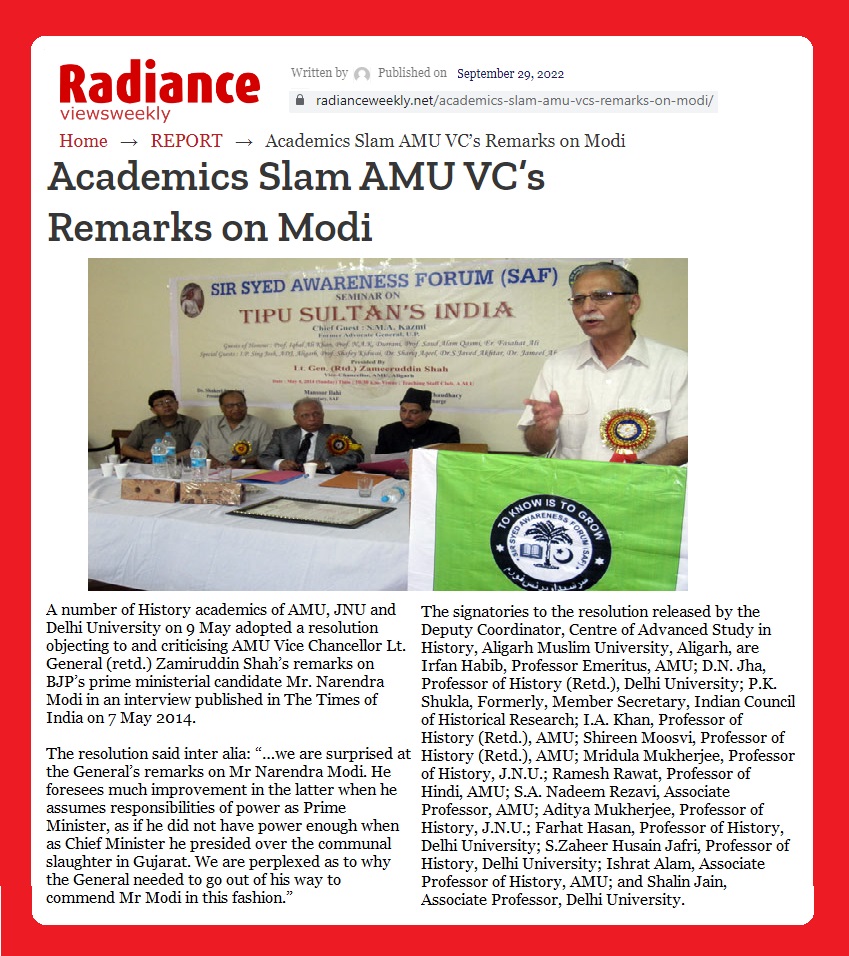
“secular and scientific study of history”: KU VC, Prof T Ramesh, who presided over the programme, has praised the IHC for its secular and scientific study of history. He reminded the audience that the KU hosted the IHC in 1993. Registrar Prof T Srinivas Rao, outgoing General President of IHC Prof Kesavan Veluthat, and several other noted historians were present. Again the problem has been what is exactly “secular and scientific study of history”, what is “secular and scientific study ..” etc., when the IHC members have been reading, listening and watching the papers, books, speeches and acts of the elite, emeritus and popular historians.
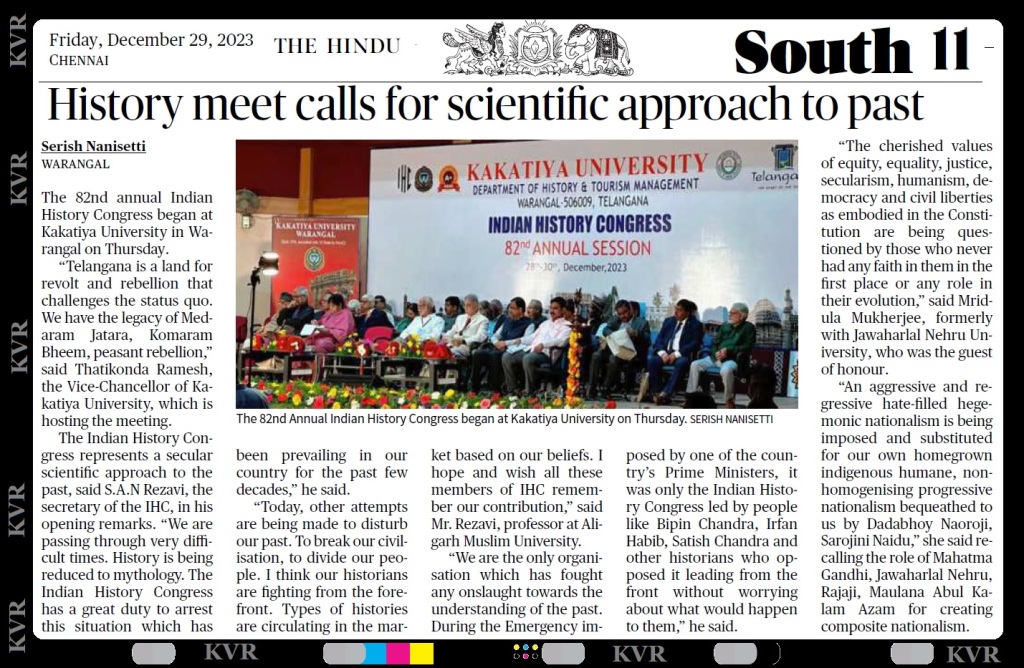
KU Vice-Chancellor appeals to historians to research Kakatiya irrigation system: Kakatiya University (KU) Vice-Chancellor, Prof Thatikonda Ramesh, emphasised the imperative for historians to adopt a scientific approach to studying history amidst contemporary challenges[17]. Addressing the valedictory session of the 82nd session of the Indian History Congress (IHC), Prof Thatikonda Ramesh highlighted the dwindling interest in historical disciplines, stressing the responsibility of historians and researchers to revive this interest[18]. He underlined the crucial role of history in administration and lamented the lack of enthusiasm for social sciences, contrasting it with the rapid advancements in technology. Prof Ramesh also praised the enduring usefulness of Kakatiya tanks and irrigation systems and urged members of the IHC to spearhead extensive awareness programmes for history’s study and preservation. KU Registrar Prof T Srinivasa Rao presided over the event. General President of the Indian History Congress, Prof Aditya Mukherjee, IHC Secretary SA Nadeem Rezavi and others spoke. The conference saw 1,063 researchers presenting papers over three days, culminating in the passing of several resolutions during the session.

Valedictory session: Deputy Chief Minister Mallu Bhatti Vikramarka is scheduled to attend the concluding session of the IHC annual session on December 30th 2023. However, it appears that he did not turn up.
© K. V. Ramakrishna Rao
01-01-2024
[1] Telangana Today, Communal forces demonizing Nehru, says Prof Aditya Mukherjee, BY UPDATED ON – 03:25 PM, THU – 28 DECEMBER 20.23
[2] https://telanganatoday.com/communal-forces-demonizing-nehru-says-prof-aditya-mukherjee
[3] Deccan Chronicle, Adopt Nehru’s ideology to protect democracy in country: IHC, DC Correspondent, Published on: December 28, 2023 | Updated on: December 28, 2023
[4] https://www.deccanchronicle.com/nation/in-other-news/281223/uhc-calls-for-fight-against-communal-politics.html
[5] National Herald, Why they demonise Nehru, Purushottam Agrawal, Published: 14 Nov 2022, 12:00 PM
[6] https://www.nationalheraldindia.com/opinion/why-they-demonise-nehru
[7] Times of India, Demonizing Nehru has become quite the fad : Historians, Eram Agha / TNN / Updated: Nov 12, 2015, 20:28 IST
[8] https://timesofindia.indiatimes.com/india/demonizing-nehru-has-become-quite-the-fad-historians/articleshow/49759429.cms?from=mdr
[9] Times of India, Nehru library head on Cong panel, flouts rules, Akshaya Mukul / TNN / Dec 29, 2010, 01:18 IST.
[10] https://timesofindia.indiatimes.com/india/nehru-library-head-on-cong-panel-flouts-rules/articleshow/7181440.cms?from=mdr
[11] The Telegraph, Congress confronts dark chapter 125-year history, as the party sees it, Our Special Correspondent, Published 29.12.2010, 12:00 AM.
[12] https://www.telegraphindia.com/india/congress-confronts-dark-chapter-125-year-history-as-the-party-sees-it/cid/450385
[13] Indian express, AMU prof suspended for objectionable FB post, By: Press Trust of India, Aligarh | July 24, 2014 04:34 IST
[14] https://indianexpress.com/article/cities/lucknow/amu-prof-suspended-for-objectionable-fb-post/
[15] Radiance weekly, Academics Slam AMU VC’s Remarks on Modi, Written by…., Published on September 29, 2022 https://radianceweekly.net/academics-slam-amu-vcs-remarks-on-modi/
[16] The signatories to the resolution released by the Deputy Coordinator, Centre of Advanced Study in History, Aligarh Muslim University, Aligarh, are Irfan Habib, Professor Emeritus, AMU; D.N. Jha, Professor of History (Retd.), Delhi University; P.K. Shukla, Formerly, Member Secretary, Indian Council of Historical Research; I.A. Khan, Professor of History (Retd.), AMU; Shireen Moosvi, Professor of History (Retd.), AMU; Mridula Mukherjee, Professor of History, J.N.U.; Ramesh Rawat, Professor of Hindi, AMU; S.A. Nadeem Rezavi, Associate Professor, AMU; Aditya Mukherjee, Professor of History, J.N.U.; Farhat Hasan, Professor of History, Delhi University; S.Zaheer Husain Jafri, Professor of History, Delhi University; Ishrat Alam, Associate Professor of History, AMU; and Shalin Jain, Associate Professor, Delhi University.
[17] Telangana Today, KU Vice-Chancellor appeals to historians to research Kakatiya irrigation system. PUBLISHED DATE – 08:54 PM, SAT – 30 DECEMBER 23
[18] https://telanganatoday.com/ku-vice-chancellor-appeals-to-historians-to-research-kakatiya-irrigation-system

Filed under: Hinduism, historian, historian politician, historical politician, historicity, historiography, historiosophy, history, history curriculum, history ideology, history usage, history useful, history useless, ICHR, ICHR member, iconoclasm, india that is bharat, indology, indus symbol, interpretation, invasion, invention, Irfan Habib, secession, sectarian, sectarian faith, sectarianism, secular, secular historian, secular historiography, secular history, secularism | Tagged: Aditya Mukherjee, bjp, communal, communalism, education, history, India, mridula, Mridula Mahajan, mridula mukherjee, nehru, nehru model, nehruvian model, RSS, saffronization, sangh parivar, sect, sectarian, sectarian conflict, sectarian violence, sectarianism, secular, secular historian, secular historiography, secular history, secularism | Leave a comment »




















